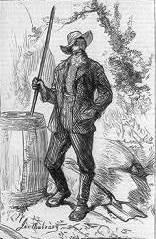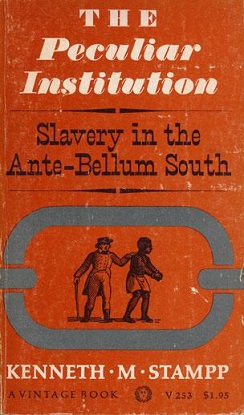
White trash is a derogatory racial and class-related slur used in American English to refer to poor white people, especially in the rural areas of the southern United States. The label signifies a social class inside the white population and especially a degraded standard of living. It is used as a way to separate the "noble and hardworking" "good poor" from the lazy, "undisciplined, ungrateful and disgusting" "bad poor". The use of the term provides middle- and upper-class whites a means of distancing themselves from the poverty and powerlessness of poor whites, who cannot enjoy those privileges, as well as a way to disown their perceived behavior.
The Methodist Episcopal Church, South was the American Methodist denomination resulting from the 19th-century split over the issue of slavery in the Methodist Episcopal Church (MEC). Disagreement on this issue had been increasing in strength for decades between churches of the Northern and Southern United States; in 1845 it resulted in a schism at the General Conference of the MEC held in Louisville, Kentucky.
Sectionalism is loyalty to one's own region or section of the country, rather than to the country as a whole. Sectionalism occurs in many countries, such as in the United Kingdom.

Mountain whites were white Americans living in Appalachia and the inland region of the Antebellum South. They were generally small farmers, who inhabited the valleys of the Appalachian range from western Virginia spanning down to northern Georgia and northern Alabama.
The Black Codes, sometimes called the Black Laws, were laws which governed the conduct of African Americans. In 1832, James Kent wrote that "in most of the United States, there is a distinction in respect to political privileges, between free white persons and free colored persons of African blood; and in no part of the country do the latter, in point of fact, participate equally with the whites, in the exercise of civil and political rights." Although Black Codes existed before the Civil War and although many Northern states had them, the Southern U.S. states codified such laws in everyday practice. The best known of these laws were passed by Southern states in 1865 and 1866, after the Civil War, in order to restrict African Americans' freedom, and in order to compel them to work for either low or no wages.

During the historical timeline of the Southern United States, the Antebellum Period extended from the conclusion of the War of 1812 to the start of the American Civil War in 1861. This era in the South's history was marked by the prevalent practice of slavery and the associated societal norms it cultivated. Over the course of this period, Southern leaders underwent a transformation in their perspective on slavery. Initially regarded as an awkward and temporary institution, it gradually evolved into a defended concept, with proponents arguing for its positive merits, while simultaneously vehemently opposing the burgeoning abolitionist movement.
Ulrich Bonnell Phillips was an American historian who largely defined the field of the social and economic studies of the history of the Antebellum South and slavery in the U.S. Phillips concentrated on the large plantations that dominated the Southern economy, and he did not investigate the numerous small farmers who held few slaves. He concluded that plantation slavery produced great wealth, but was a dead end, economically, that left the South bypassed by the industrial revolution underway in the North.
Social class is an important theme for historians of the United States fordecades. The subject touches on many other elements of American history such as that of changing U.S. education, with Greater education attainment leading to expanding household incomes for many social groups. The overall level of prosperity grew greatly in the U.S. through the 20th century as well as the 21st century, anchored in changes such as growing American advances in science and technology with American inventions such as the phonograph, the portable electric vacuum cleaner, and so on. Yet much of the debate has focused lately on whether social mobility has fallen in recent decades as income inequality has risen, what scholars such as Katherine S. Newman have called the "American nightmare."
Frank Lawrence Owsley was an American historian who taught at Vanderbilt University for most of his career, where he specialized in Southern history and was a member of the Southern Agrarians. He is notorious for his essay "The Irrepressible Conflict" (1930) in which he lamented the economic loss of slavery for the defeated Confederacy and of the "half savage blacks" that had been freed. He is also known for his study of Confederate diplomacy based on the idea of "King Cotton" and especially his quantitative social history of the middling "plain people" of the Old South.
Plain Folk of the Old South is a 1949 book by Vanderbilt University historian Frank Lawrence Owsley, one of the Southern Agrarians. In it he used statistical data to analyze the makeup of Southern society, contending that yeoman farmers made up a larger middle class than was generally thought.
The health of slaves on American plantations was a matter of concern to both slaves and their owners. Slavery had associated with it the health problems commonly associated with poverty. It was to the economic advantage of owners to keep their working slaves healthy, and those of reproductive age reproducing. Those who could not work or reproduce because of illness or age were sometimes abandoned by their owners, expelled from plantations, and left to fend for themselves.

The Slave Community: Plantation Life in the Antebellum South is a book written by American historian John W. Blassingame. Published in 1972, it is one of the first historical studies of slavery in the United States to be presented from the perspective of the enslaved. The Slave Community contradicted those historians who had interpreted history to suggest that African-American slaves were docile and submissive "Sambos" who enjoyed the benefits of a paternalistic master–slave relationship on southern plantations. Using psychology, Blassingame analyzes fugitive slave narratives published in the 19th century to conclude that an independent culture developed among the enslaved and that there were a variety of personality types exhibited by slaves.
Bertram Wyatt-Brown was a noted historian of the Southern United States. He was the Richard J. Milbauer Professor Emeritus at the University of Florida, where he taught from 1983-2004; he also taught at Case Western University for nearly two decades. He studied the role of honor in southern society, in all classes, and wrote a family study of the Percy Family, including twentieth-century authors William Alexander Percy and Walker Percy.

The Peculiar Institution: Slavery in the Ante-Bellum South is a non-fiction book about slavery published in 1956, by Kenneth M. Stampp of the University of California, Berkeley, and other universities. The book describes and analyzes multiple facets of slavery in the American South from the 17th through the mid-19th century, including demographics, lives of slaves and slaveholders, the Southern economy and labor systems, the Northern and abolitionist response, slave trading, and political issues of the time.

First Baptist Church was the first Baptist church in Petersburg, Virginia; one of the first African-American Baptist congregations in the United States, and one of the oldest black churches in the nation. It established one of the first local schools for black children in the nation.

Invisible churches among enslaved African Americans in the United States were informal Christian groups where enslaved people listened to preachers that they chose without their slaveholder's knowledge. The Invisible churches taught a different message from white-controlled churches and did not emphasize obedience. Some slaves could not contact invisible churches and others did not agree with an invisible church's message but many slaves were comforted by the invisible churches.
Thomas Erskine Clarke is a Professor Emeritus of American Religious History at Columbia Theological Seminary, best known for his books Dwelling Place and By the Rivers of Water.

Plantation complexes were common on agricultural plantations in the Southern United States from the 17th into the 20th century. The complex included everything from the main residence down to the pens for livestock. Until the abolition of slavery, such plantations were generally self-sufficient settlements that relied on the forced labor of enslaved people.
Caesar Blackwell (1769–1845) was an enslaved African-American preacher in Alabama, one of a number of black preachers in the South who preached to a mixed congregation. He was either bought or freed by the Alabama Baptist Association, and preached in the Antioch Baptist Church in Montgomery County, Alabama.

The Black Belt in the American South refers to the social history, especially concerning slavery and black workers, of the geological region known as the Black Belt. The geology emphasizes the highly fertile black soil. Historically, the black belt economy was based on cotton plantations – along with some tobacco plantation areas along the Virginia-North Carolina border. The valuable land was largely controlled by rich whites, and worked by very poor, primarily black slaves who in many counties constituted a majority of the population. Generally the term is applied to a larger region than that defined by its geology.









